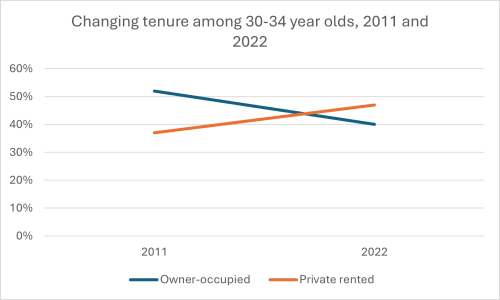
Wednesday, 03 April 2024.
Over recent decades there has been a fall across the population in the proportion of owner-occupied households and an increase in the proportion of rented households, particularly private rented, but also social rented.
The changing pattern in owner-occupied and private rented households is most stark among those in their thirties. In 2011, for example, the majority (52%) of 30–34-year-old heads of households owned their own homes while over one-third (37%) rented privately. By 2022 however, the balance had shifted with the majority in private rented accommodation (47%), and home ownership down to 40%.

This increased reliance on the private rental market, evident across all age groups over 25 years of age, is concerning given the private rental market is a known gateway to homelessness. Over 40% of single adult new presentations to emergency accommodation here in the Southwest came from the private rented sector in the last quarter of 2023.
This is no surprise given the rate of notices of terminations. According to RTB (Residential Tenancies Board) data, 2,180 notices of termination were issues in Cork in 2023.
These renters face the dreaded challenge of finding and securing another rental home when supply is at an all-time low and rents are rising, especially for new tenancies. In Cork city for example, according to the RTB, rents for new tenancies increased 7.4% in the twelve months to Q3, 2023, growing more than twice as fast as existing rents and bringing the average rent for a new tenancy to €1,497 per month – €327 higher than existing rents.
As a private renter in the RTB Tenant Survey put it: “You have no security – especially with the way the market is. Everyone is just dreading getting a notice of termination.”
Compounding younger adults increasing reliance on a precarious private rental market, they are less likely than other age groups to secure social rental accommodation.
While the proportion of households in social rental housing in Cork increased across all age groups from 2011 to 2016, it decreased among 25–34-year-olds from 2016 to 2022, while continuing to increase among all other age groups. A similar pattern is seen nationally.
Social housing allocations must at a minimum be maintained but must also increase for younger adults, as they have for other age groups.